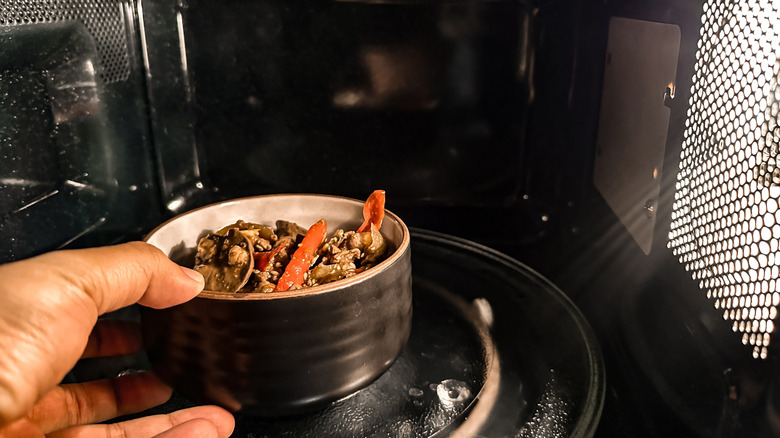The Warning Sign That Your Takeout Could Make You Sick
After a long day, or even a normal day, you can order takeout from pretty much any of your devices. (Yes, you can even order dinner from your TV, for some reason.) Once you pick up your food or it's dropped on your porch via the beloved no-contact food delivery, there's one sign to look out for in order to avoid getting sick: If you ordered hot takeout food and it arrives at room temperature, you may be in trouble.
When you order a cooked meal from a restaurant, the maximum time it can be left out at room temperature is two hours and one hour in temperatures above 90 degrees Fahrenheit. This doesn't only refer to the minutes in the delivery driver's car; this also includes the time the food spends on your dining room table or coffee table while you pick out a show to watch and the time it takes you to eat it.
Once that cooked meal falls within what's known as the danger zone — for hot foods, that's temperatures below 140 degrees Fahrenheit — it becomes a hub for bacteria, which can each double in number every twenty minutes while the food remains in this temperature range. If your food arrives and it's already at room temperature, there's no way to know how long it's been in the danger zone. So to prevent illness, it shouldn't be consumed.
Reheating your food may not eliminate the risk
If you plan to reheat the food to mitigate the risk of illness, it's important to know that reheated food needs an internal temperature of 165 degrees Fahrenheit. When reheating food in the oven, set the temperature for at least 325 degrees Fahrenheit while also keeping in mind that internal temperature of 165 degrees Fahrenheit. And if you want to be extra thorough (as you should be), use a food thermometer to check the temperature of the thickest part of the food to make sure it's cooked.
Know that your microwave isn't necessarily a savior in this situation, and for a few reasons. The first is that microwaves can cook food unevenly, depending on the amount and shape of what you place inside. If you've ever experienced a hot bowl and cold food after microwaving something, you know what I'm talking about. Any leftover cold spots will still be a home to bacteria.
The second problem is common food-borne bacteria like Staphylococcus, or staph, produce a heat-resistant toxin that can only be eliminated by temperatures above 140 degrees Fahrenheit. Staph can cause symptoms like nausea, vomiting, cramping, and more, and your microwave may not be able to attain the temperature needed to stop its growth. And if you're thinking about reheating your takeout meal in a slow cooker, forget it, because it keeps the food in the danger zone for far too long.
All in all, if your takeout arrives at room temperature, it may be best to cut your losses and replace it to avoid food poisoning.

